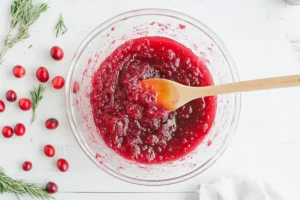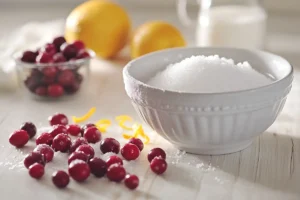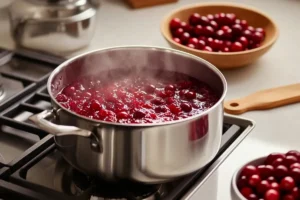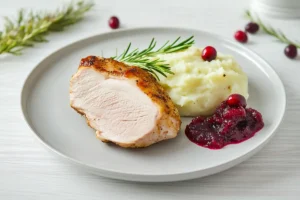What Do You Eat Thanksgiving Cranberry Sauce With? 10 Tasty Pairings to Try
Thanksgiving is a time for family, gratitude, and, of course, delicious food. Among the many dishes that grace the holiday table, cranberry sauce holds a special place. Its vibrant color and tangy-sweet flavor make it a standout side, but have you ever wondered what to pair it with beyond the classic turkey? In this article, we’ll explore traditional and creative ways to enjoy cranberry sauce, from classic Thanksgiving staples to unexpected delights. Whether you’re a cranberry sauce purist or an adventurous foodie, you’ll find plenty of inspiration to elevate your holiday feast.
What is Cranberry Sauce?
A Brief History of Cranberry Sauce
Cranberry sauce has been a Thanksgiving staple for centuries, with its roots tracing back to Native American traditions. Indigenous peoples used cranberries as a food source and even mixed them with dried meat and fat to create pemmican, a long-lasting energy bar. When European settlers arrived, they adopted cranberries into their cooking, eventually leading to the creation of the sweetened cranberry sauce we know today.
The modern version gained popularity in the early 20th century when Ocean Spray began marketing canned cranberry sauce, making it a convenient addition to holiday meals. Today, cranberry sauce comes in many forms, from jellied to whole berry, and remains a beloved part of Thanksgiving celebrations.
External Resource: For a deeper dive into the history of cranberries, check out this article from Smithsonian Magazine.
Traditional Pairings for Thanksgiving Cranberry Sauce
Turkey
No Thanksgiving meal is complete without turkey, and cranberry sauce is its perfect companion. The tartness of the sauce cuts through the richness of the turkey, creating a balanced flavor profile that’s both satisfying and refreshing. Whether you prefer to spread it on each bite or serve it as a side, cranberry sauce adds a festive touch to this holiday centerpiece.
Creative and Unexpected Pairings
Sandwiches and Wraps
Cranberry sauce isn’t just for Thanksgiving dinner—it’s also a fantastic addition to leftovers! One of the most popular ways to enjoy it is in a post-Thanksgiving sandwich. Layer slices of turkey, a smear of cranberry sauce, and a handful of greens between two pieces of bread for a quick and delicious meal. For a gourmet twist, add creamy brie or sharp cheddar cheese. Cranberry sauce also works wonders in wraps, adding a sweet and tangy kick to your lunch.
Dietary Considerations and Alternatives
Vegan and Vegetarian Options
If you’re hosting guests with dietary restrictions, cranberry sauce is a versatile dish that can easily be adapted. For a vegan version, simply swap out honey or refined sugar for maple syrup or agave nectar. Pair it with plant-based mains like roasted cauliflower steak or lentil loaf for a festive, inclusive meal. Many store-bought cranberry sauces are also vegan-friendly, so be sure to check the label if you’re short on time.
How to Make Your Own Cranberry Sauce
Basic Recipe
Making cranberry sauce from scratch is easier than you might think, and the results are far superior to the canned version. Here’s a simple recipe to get you started:
Ingredients:
- 12 oz fresh cranberries
- 1 cup granulated sugar
- 1 cup water or orange juice
- Optional: orange zest, cinnamon, or a splash of vanilla extract
Instructions:
- In a medium saucepan, combine cranberries, sugar, and water (or orange juice).
- Bring to a boil over medium heat, stirring occasionally.
- Reduce heat and simmer for 10-15 minutes, until the cranberries burst and the sauce thickens.
- Remove from heat and stir in any optional add-ins like orange zest or cinnamon.
- Let cool before serving. Store leftovers in the refrigerator for up to a week.
Cranberry Sauce Around the World
While cranberry sauce is a Thanksgiving classic in the United States, other cultures have their own unique ways of incorporating cranberries into their cuisines. Exploring these global variations can add an exciting twist to your holiday table or inspire new culinary adventures.
European Cranberry Traditions
In Scandinavia, cranberries are often used in sauces and jams to accompany savory dishes like meatballs or roasted meats. In Sweden, lingonberry sauce (a close relative of cranberry sauce) is a staple served with dishes such as köttbullar (Swedish meatballs). The tartness of the berries pairs perfectly with rich, savory flavors.
In Eastern Europe, cranberries are used in compotes—a sweet, fruity drink made by boiling cranberries with sugar and water. This refreshing beverage is often served during holidays and celebrations.
Cranberries in Asian Cuisine
In some parts of Asia, cranberries are used in both sweet and savory dishes. For example, in China, dried cranberries are often added to rice dishes or used as a garnish for desserts. Their tartness provides a delightful contrast to the sweetness of traditional Asian pastries and puddings.
Canadian Cranberry Innovations
Canada is one of the largest producers of cranberries in the world, and Canadians have embraced this berry in creative ways. In addition to traditional cranberry sauce, Canadians enjoy cranberries in baked goods, salads, and even cocktails. Cranberry-glazed salmon is a popular dish that showcases the berry’s versatility.
How to Incorporate Global Flavors into Your Cranberry Sauce
Why not take inspiration from these global traditions and add a unique twist to your cranberry sauce? Here are a few ideas:
- Add a splash of red wine or port for a European-inspired sauce.
- Mix in ginger or star anise for an Asian-inspired flavor profile.
- Use maple syrup instead of sugar for a Canadian twist.
Conclusion
Cranberry sauce is more than just a side dish—it’s a versatile, flavorful addition to your Thanksgiving table and beyond. Whether you stick to traditional pairings like turkey and stuffing or venture into creative territory with sandwiches and desserts, there’s no wrong way to enjoy this holiday favorite. With a simple homemade recipe and plenty of pairing ideas, you’re ready to make this year’s Thanksgiving meal unforgettable.
What’s your favorite way to enjoy cranberry sauce? Share your ideas in the comments below!
Cranberry Sauce as a Gift Idea
Homemade cranberry sauce isn’t just for your holiday table—it also makes a thoughtful and festive gift! Package it in a mason jar, tie it with a ribbon, and attach a handwritten label with serving suggestions. Pair it with a box of crackers, a wheel of brie, or a bottle of wine for a complete gift basket. Your friends and family will appreciate the personal touch, and it’s a great way to share the flavors of the season.
FAQs About Cranberry Sauce
Cranberry sauce is a beloved Thanksgiving staple, but it often raises questions for home cooks and holiday hosts. Here are answers to some of the most frequently asked questions about cranberry sauce:
Can You Freeze Cranberry Sauce?
Yes, cranberry sauce freezes beautifully! Store it in an airtight container or freezer bag for up to 2 months. Thaw it in the refrigerator overnight before serving. Freezing is a great way to make cranberry sauce ahead of time and reduce last-minute prep during the holidays.
How Long Does Homemade Cranberry Sauce Last?
Homemade cranberry sauce can be stored in the refrigerator for up to 1 week. Keep it in a sealed container to maintain freshness. If you notice any off smells or mold, it’s best to discard it.
Can I Use Frozen Cranberries to Make Cranberry Sauce?
Absolutely! Frozen cranberries work just as well as fresh ones. There’s no need to thaw them before cooking—just add them directly to the pot and adjust the cooking time slightly if needed.
Is Cranberry Sauce Gluten-Free?
Most cranberry sauce recipes are naturally gluten-free, but always double-check the ingredients if you’re using a store-bought version. Some brands may include additives or thickeners that contain gluten.
What Can I Do If My Cranberry Sauce Is Too Tart?
If your cranberry sauce is too tart, balance it out by stirring in a bit more sugar, honey, or maple syrup. You can also add a splash of orange juice or a pinch of cinnamon to mellow the flavor.
Can I Make Cranberry Sauce Without Sugar?
Yes! You can make a sugar-free cranberry sauce using natural sweeteners like stevia, monk fruit, or unsweetened applesauce. Keep in mind that the texture and flavor may differ slightly from traditional recipes.
What’s the Difference Between Jellied and Whole Berry Cranberry Sauce?
Jellied cranberry sauce is smooth and gelatinous, made by straining the cooked cranberries to remove the skins and seeds. Whole berry cranberry sauce includes the entire fruit, giving it a chunkier texture. Both are delicious—it just comes down to personal preference!
Can I Add Alcohol to Cranberry Sauce?
Definitely! A splash of red wine, port, or even orange liqueur can add depth and complexity to your cranberry sauce. Just add it during the cooking process so the alcohol has time to cook off, leaving behind only the flavor.
What’s the Best Way to Reheat Cranberry Sauce?
Reheat cranberry sauce gently on the stovetop over low heat, stirring occasionally. If it’s too thick, add a splash of water or orange juice to loosen it up. You can also microwave it in short intervals, stirring in between.




